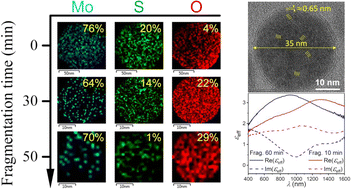Tunable optical properties of transition metal dichalcogenide nanoparticles synthesized by femtosecond laser ablation and fragmentation†
Abstract
Manipulation of resonant dielectric nanostructures is of paramount importance for next-generation photonic devices. Traditionally, researchers use two-dimensional or phase-change materials for this purpose. However, the former leads to small efficiency, while the latter lacks continuous changes. Here, we provide an alternative approach through laser-induced modification. Specifically, via a laser ablation process we synthesized molybdenum disulfide (MoS2) nanoparticles (NPs), the composition of which we then controlled through laser fragmentation. It causes a transformation of MoS2 into its oxide MoO3−x, which, in turn, results in pronounced modification of the optical response, owing to a large difference between their optical constants. In addition, laser-fragmented NPs have a several times larger photothermal response, compared to the original MoS2 and classical silicon NPs. Thus, our MoS2-based laser-tunable NPs open up a new perspective for resonant nanophotonics, in particular, photothermal therapy.

- This article is part of the themed collection: Journal of Materials Chemistry C HOT Papers


 Please wait while we load your content...
Please wait while we load your content...